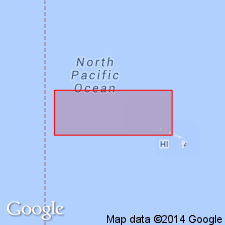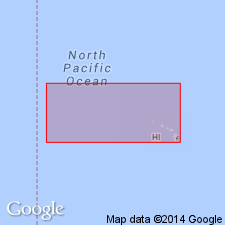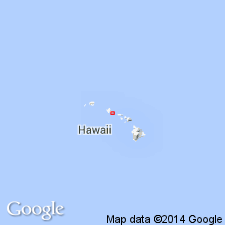
- Usage in publication:
-
- Castle volcanics*
- Modifications:
-
- Original reference
- Dominant lithology:
-
- Basalt
- AAPG geologic province:
-
- Oahu
Summary:
Castle volcanics. Nepheline basalt. Bedded cinders, bombs, and spatter composing a partly eroded cinder cone from which a lava flow, over 100 feet thick, extends for half a mile. Included in middle part of Honolulu volcanic series. Unconformably overlies older rocks [Kailua volcanic series (new)] on southwest side of cone. Tentatively assigned to middle(?) and late Pleistocene Waipo stand of sea on basis of weathering, although "flow appears to have been etched into cliffs on north by the Waimanalo sea." [Age is considered late Pleistocene.]
Named for occurrence at cinder cone on Castle Ranch, 3 mi west of Kailua and 0.25 mi north of Ulumawao (summit), [Kaneohe 7.5-min quadrangle, Honolulu Co.], Island of Oahu, HI. Covers area of about 0.5 sq mi north of Ulumawao peak, on northeast side of Koolau Range, about 10 mi northwest of Makapuu Head.
[Additional locality information from USGS GNIS database and USGS historical topographic map collection TopoView, accessed on July 20, 2023.]
Source: US geologic names lexicon (USGS Bull. 896, p. 365); GNU records (USGS DDS-6; Menlo GNULEX).

- Usage in publication:
-
- Castle volcanics*
- Modifications:
-
- Age modified
- AAPG geologic province:
-
- Oahu
Summary:
Petrographically and in degree of weathering and erosion unit resembles Ainoni, Maunawili, and Training School volcanics [on Island of Oahu] and is tentatively correlated with them. Assigned Pleistocene age.
Source: GNU records (USGS DDS-6; Menlo GNULEX).

- Usage in publication:
-
- Castle Volcanics*
- Modifications:
-
- Geochronologic dating
- AAPG geologic province:
-
- Oahu
Summary:
K-Ar ages on nepheline-melilite from Castle lava flow, Oahu gave 860 +/-10 to 846 +/-8 Ma.
Source: GNU records (USGS DDS-6; Menlo GNULEX).

- Usage in publication:
-
- Castle Volcanics*
- Modifications:
-
- Geochronologic dating
- AAPG geologic province:
-
- Oahu
Summary:
K-Ar "ages [from Castle Volcanics on Oahu] of Gramlich and others (1971) were recalculated with decay constants used in this study" to be 0.874 +/-0.006 Ma.
Source: GNU records (USGS DDS-6; Menlo GNULEX).

- Usage in publication:
-
- Castle Volcanics†
- Modifications:
-
- Abandoned
- AAPG geologic province:
-
- Oahu
Summary:
Castle Volcanics (Stearns, IN Stearns and Vaksvik, 1935) abandoned as formally named unit and called Castle flow (and associated cone), informal unit of Honolulu Volcanics. [assigned Pleistocene age based on isotopic dating (Lanphere and Dalrymple, 1980)]
Source: GNU records (USGS DDS-6; Menlo GNULEX).
For more information, please contact Nancy Stamm, Geologic Names Committee Secretary.
Asterisk (*) indicates published by U.S. Geological Survey authors.
"No current usage" (†) implies that a name has been abandoned or has fallen into disuse. Former usage and, if known, replacement name given in parentheses ( ).
Slash (/) indicates name conflicts with nomenclatural guidelines (CSN, 1933; ACSN, 1961, 1970; NACSN, 1983, 2005, 2021). May be explained within brackets ([ ]).

